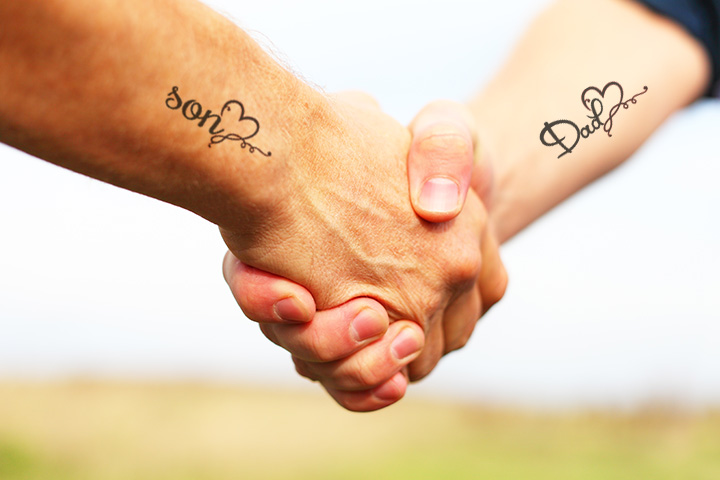

Another example of such accidental tattoos is the result of a deliberate or accidental stabbing with a pencil or pen, leaving graphite or ink beneath the skin. An amalgam tattoo is when amalgam particles are implanted in to the soft tissues of the mouth, usually the gums, during dental filling placement or removal. These are particularly difficult to remove as they tend to be spread across several layers of skin, and scarring or permanent discoloration is almost unavoidable depending on the location. Coal miners could develop characteristic tattoos owing to coal dust getting into wounds.
LIKE FATHER LIKE SON TATTOOS PROFESSIONAL
The American Academy of Dermatology distinguishes five types of tattoos: traumatic tattoos, also called "natural tattoos", that result from injuries, especially asphalt from road injuries or pencil lead amateur tattoos professional tattoos, both via traditional methods and modern tattoo machines cosmetic tattoos, also known as " permanent makeup" and medical tattoos.Ī traumatic tattoo occurs when a substance such as asphalt or gunpowder is rubbed into a wound as the result of some kind of accident or trauma. "Impicit in the classification was an evolutionary development from the most primitive form of body modification to the most sophisticated. The fourth and the last is scarification by irritating and re-opening a preexisting wound, and re-scarification to form a raised scar as found in places including Tasmania, Australia, Melanesia, and Central Africa. The third is scarification using a knife or chisel as found in places including West Africa.
LIKE FATHER LIKE SON TATTOOS SKIN
The second is a tattoo combined with chiseling to leave furrows in the skin as found in places including New Zealand. The first is by pricking that leaves the skin smooth as found in places including the Pacific Islands. Japanese may use the word tattoo to mean non-Japanese styles of tattooing.īritish anthropologist Ling Roth in 1900 described four methods of skin marking and suggested they be differentiated under the names "tatu", " moko", " cicatrix", and " keloid".

The most common word used for traditional Japanese tattoo designs is horimono. The Japanese word irezumi means "insertion of ink" and can mean tattoos using tebori, the traditional Japanese hand method, a Western-style machine or any method of tattooing using insertion of ink. Flash sheets are prominently displayed in many tattoo parlors for the purpose of providing both inspiration and ready-made tattoo images to customers. It is called Tisheret and Washem in the Amazigh ( Berber) culture.Ĭopyrighted tattoo designs that are mass-produced and sent to tattoo artists are known as " flash", a notable instance of industrial design. In this case, the English word tattoo is derived from the Dutch word taptoe. The etymology of the body modification term is not to be confused with the origins of the word for the military drumbeat or performance - see military tattoo. In Marquesan, tatu." Before the importation of the Polynesian word, the practice of tattooing had been described in the West as painting, scarring, or staining.

From Polynesian (Samoan, Tahitian, Tongan, etc.) tatau. The Oxford English Dictionary gives the etymology of tattoo as "In 18th c. The word tattoo, or tattow in the 18th century, is a loanword from the Samoan word tatau, meaning "to strike". A Māori chief with tattoos ( moko) seen by Cook and his crew (drawn by Sydney Parkinson 1769), engraved for A Journal of a Voyage to the South Seas by Thomas Chambers


 0 kommentar(er)
0 kommentar(er)
